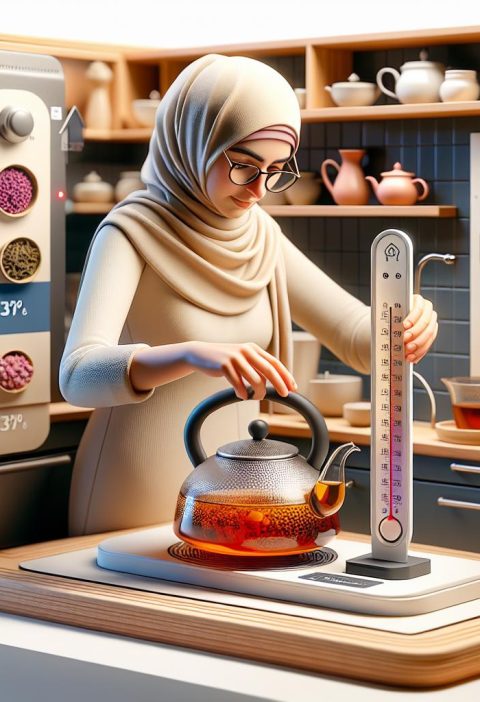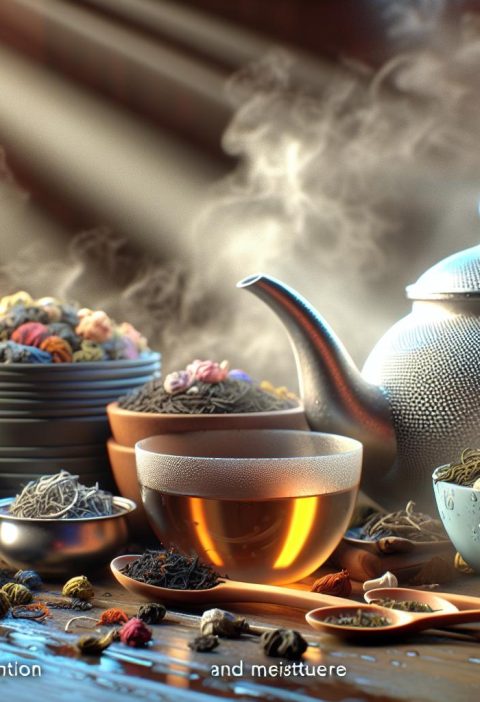Welcome to the world of tea, where every sip tells a story of tradition and flavor. Whether you’re a seasoned tea enthusiast or just starting to explore the vast array of options, understanding the basics of steeping and storage is essential. We’ll guide you through the art of brewing the perfect cup and preserving the freshness of your favorite teas.
Steeping tea is not just about dunking a bag in hot water; it’s a delicate process that requires precision and care. From water temperature to steeping time, each factor plays a crucial role in unlocking the full potential of your tea leaves. Join us as we unravel the secrets to achieving the ideal brew that tantalizes your taste buds and soothes your soul.
When it comes to storing tea, proper preservation is key to maintaining its aroma and taste. Whether you prefer green, black, or herbal teas, knowing how to store them correctly ensures longevity and quality. Let’s delve into the world of tea storage solutions, from airtight containers to ideal storage conditions, so you can savor every cup as if it were freshly brewed.
The Art of Steeping Tea
Tea steeping is a delicate process that can significantly impact the flavor and aroma of your brew. Whether you are a novice or a seasoned tea enthusiast, mastering the art of steeping tea is crucial for a satisfying tea-drinking experience.
For Beginners: Mastering the Basics:
- Start with loose leaf tea for a more flavorful brew.
- Use the proper tea-to-water ratio for optimal taste.
- Experiment with steeping times to find your preferred strength.
- Pay attention to water temperature for different types of tea.
- Invest in a reliable tea infuser for easy steeping.
For Intermediate Tea Lovers: Enhancing Your Brew
- Explore different tea varieties to expand your tea palate.
- Focus on the quality of water used for steeping.
- Consider multiple infusions to extract different flavors.
- Experiment with temperature-controlled kettles for precision.
- Learn about tea blending to create unique flavor profiles.
- Source high-quality tea leaves for a superior taste.
- Master the art of gongfu cha for a traditional steeping method.
- Utilize tea tasting sets to enhance your sensory experience.
- Discover the world of aged teas for complex flavors.
- Study the influence of terroir on tea flavor profiles.
Tea steeping is a journey that allows us to appreciate the intricate flavors and aromas of this beloved beverage. Whether you are just starting or have been enjoying tea for years, honing your steeping skills will elevate your tea-drinking ritual to new heights.
Factors Influencing Steeping Process

When it comes to the perfect cup of tea, mastering the steeping process is crucial. Understanding the factors that influence this can elevate your tea experience to new heights. Whether you’re a novice or a seasoned tea connoisseur, knowing how these variables impact your brew is key. Let’s delve into the specifics to help you achieve your desired tea taste:
For Beginners: Getting Started Right
- Tea Type: Different teas require different steeping times and water temperatures. Start with green or white teas for a lighter introduction.
- Water Quality: Always use fresh, filtered water to avoid any undesirable flavors in your tea.
- Steeping Time: Follow the guidelines for each tea type to avoid over-extraction and bitterness.
- Tea-to-Water Ratio: Begin with the standard ratio of 1 teaspoon of tea per 8 ounces of water.
For Intermediate Tea Enthusiasts: Refining Your Technique
- Experimentation: Don’t be afraid to adjust the parameters to suit your taste preferences. Try longer or shorter steeping times to find your sweet spot.
- Tea Varieties: Explore oolong or black teas for a more robust flavor profile and complexity.
- Water Temperature: Invest in a temperature-controlled kettle to ensure precision brewing.
- Multiple Infusions: Some teas can be steeped multiple times, revealing different flavors with each brew.
- Gongfu Cha: Dive into the world of traditional Chinese tea brewing for a ritualistic and intricate experience.
- Tea Tasting Sets: Invest in a quality tasting set to appreciate the nuances and aromas of different teas.
- Aged Teas: Delve into the realm of aged and fermented teas for a unique and complex flavor journey.
Perfecting the Steeping Time
Steeping time is a critical factor in extracting the optimal flavors and aromas from your tea. Let’s dive into how you can perfect this essential element based on your experience level.
For Beginners: Mastering the Basics
- Tea Types: Stick to green or white teas for a gentle introduction.
- Steeping Time: Start with 2-3 minutes to avoid bitterness.
- Experiment: Adjust time gradually to find your perfect brew.
For Intermediate Enthusiasts: Enhancing Your Tea
- Tea Variety: Explore oolong or black teas for more complexity.
- Steeping Parameters: Fine-tune steeping time between 3-5 minutes.
- Investment: Consider a temperature-controlled kettle for precision.
- Gongfu Cha: Embrace the art of gongfu cha for a ritualistic experience.
- Aged Teas: Delve into the world of aged teas for rich, nuanced flavors.
- Tea Tasting Sets: Invest in a quality tea tasting set for sensory exploration.
| Beginners: | Steep green or white teas for 2-3 minutes. |
| Intermediate: | Experiment with oolong or black teas for 3-5 minutes. |
| Advanced: | Explore gongfu cha and aged teas for unique tea experiences. |
Tea Storage Essentials
When it comes to storing your tea properly, there are a few essential practices to keep in mind to preserve its flavor and freshness. Let’s delve into the key aspects of tea storage that every tea enthusiast should know:
For Beginners: Getting Started with Proper Tea Storage
- Store in a Cool, Dark Place: To maintain the quality of your tea, keep it away from direct sunlight and heat.
- Airtight Containers: Invest in airtight containers to prevent moisture and odors from affecting the tea.
- Avoid Strong Odors: Tea easily absorbs odors, so store it away from strong-smelling foods or spices.
- Use What You Have: If you’re just starting your tea collection, repurpose glass jars or tins for storage.
For Intermediate Tea Lovers: Elevating Your Tea Storage Game
- Avoid Plastic Containers: Opt for glass, ceramic, or tin containers as plastic can affect the flavor of the tea.
- Consider Humidity Levels: Maintain moderate humidity levels to prevent tea leaves from becoming stale.
- Label Your Tea: Keep track of different types of tea by labeling containers with the tea’s name and date of purchase.
- Buy in Small Quantities: If possible, purchase tea in smaller amounts to ensure freshness.
- Vacuum Sealed Containers: For long-term storage, vacuum-sealed containers can help preserve the tea’s freshness.
- Temperature Control: Maintain a consistent temperature in your storage area to prevent fluctuations that can impact the tea.
- Specialized Tea Canisters: Consider investing in specialized tea canisters that are designed to protect tea from light and air exposure.
- Rotate Your Stock: Regularly rotate through your tea collection to ensure older teas are consumed before freshness diminishes.
Remember, proper tea storage plays a significant role in maintaining the flavor and quality of your favorite teas. By following these storage essentials, you can ensure that each cup you brew is a delightful experience.
Stay tuned for more insightful tips on tea steeping and storage techniques in our comprehensive guide to discovering the world of tea.
Preserving Tea Freshness

For Beginners: Essential Practices
- Store tea in cool, dark place in airtight containers.
- Avoid exposure to sunlight and moisture.
- Consider refrigeration for delicate teas.
For Intermediate Enthusiasts: Elevating Your Storage Game
- Opt for glass or ceramic containers over plastic.
- Monitor humidity levels in storage area.
- Label tea containers to track contents and purchase dates.
- Purchase small quantities to maintain freshness.
- Utilize vacuum-sealed containers to seal in freshness.
- Implement temperature control in storage space.
- Invest in specialized tea canisters for premium teas.
- Rotate tea stock regularly to ensure freshness.
Proper tea storage is key to preserving the quality and flavors of your teas, enhancing the overall brewing experience.
Conclusion
Ensuring the freshness of our tea is essential for an exceptional brewing experience. By following appropriate storage practices based on our level of expertise, we can preserve the quality and flavors of our favorite teas. From beginners to advanced enthusiasts, the key lies in storing tea in optimal conditions, such as cool, dark environments, airtight containers, and careful monitoring of factors like humidity and light exposure. By investing in suitable storage solutions and maintaining a mindful approach to tea preservation, we can elevate our tea-drinking journey and savor the full spectrum of flavors each cup has to offer. Let’s continue to explore the world of tea with a newfound appreciation for the art of steeping and storing our beloved tea leaves.






